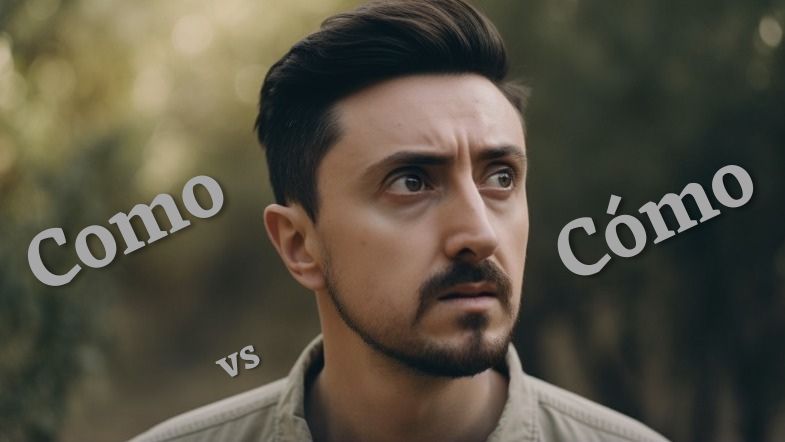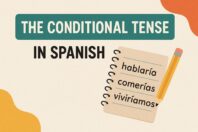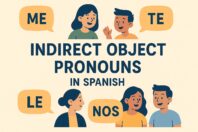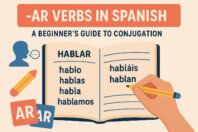Como vs Cómo: A full guide to these Spanish homonyms

Get our free email course, Shortcut to Conversational.
Have conversations faster, understand people when they speak fast, and other tested tips to learn faster.
More infoThe Spanish language, just like in English, has many homonyms: words that sound the same but have different meanings. Given the similarities of homonyms like como vs cómo, even native Spanish speakers often wonder whether to use ¿como o cómo?.
In past posts we’ve looked specifically at other Spanish homonyms whose main difference comes down to an accent, including por que vs porqué, cuanto vs cuánto, and donde vs dónde. We’ve also gone into depth on the question words in Spanish, all of which have accents. Otherwise, we have one general post with a bunch of Spanish homonyms, another specifically on nouns with the same spelling as conjugated verbs, and another on Spanish nouns with different meanings when masculine or feminine.
In this post we’ll focus on como vs cómo, so you can be sure to keep each of them clear. We’ll go through each one individually, introducing the various meanings and uses for both como and cómo. As always, we’ll demonstrate each meaning by including plenty of examples to show them used in context.
Remember that Spanish accent marks are an integral part of a word’s spelling, so como and cómo are very distinct from one another. Now, let’s start with a quick overview to compare the two, and then go deep on the accented and the unaccented words, explaining everything you need to know between como vs cómo!
Como vs Cómo: Main differences
Don’t worry, we’ll go into all the details of how to use como and cómo in the sections below, but let’s at least start with a quick overview of their main differences.
Como without an accent is generally used to introduce a situation or circumstance. It’s always followed by a noun (or a bigger clause acting as a noun) which it’s introducing. Como takes different English translations depending on its use, which can include like, as, as if, around, about, if… we’ll see each one of these below.
Cómo with an accent is a Spanish question word, or interrogative. It’s used to ask questions in various sentence structures, usually translated into English as how. It’s also sometimes used as an exclamation or interjection, including as a way to ask someone to repeat what they just said. In this sense, ¿cómo? in English can translate to what?.
Cómo: With an accent
Let’s start off first with the accented cómo, since its uses are more straightforward than those of the unaccented como. In this order, perhaps we should rename our post cómo vs como!
In general, cómo is a Spanish interrogative, also known as a question word. This cómo with an accent is usually translated into English as how, though it can take other translations depending on the context. It can be used in both direct and indirect questions, as well as question statements.
In addition to its common use as a question word, cómo is also commonly used as an interjection, or as part of one. When used in this way, the English translations can vary a lot!
Let’s see each of these uses of cómo in more detail.
As an interrogative in direct questions
This use of cómo in Spanish is the one you’re probably already familiar with: to ask direct questions.
While the easy translation of cómo in English is how, sometimes the better translation can be other options such as what or why. This basically comes down to the way the questions are formed in the two languages. The important detail to remember here is that cómo with an accent is used as a question word.
- ¿Cómo se llama tu mejor amigo? – What’s your best friend’s name?
- ¿Cómo no viniste a verme antes? – Why didn’t you come to see me before?
- ¿Cómo aprendiste a hablar español? – How did you learn to speak Spanish?
Remember that cómo is just one of the question words, all of which have accents. To review the rest of them, go to our detailed post on the Spanish interrogatives.
As an interrogative in indirect questions
In many cases, a question isn’t introduced directly with a question word. As long as we’re looking to find out information that we don’t know, we still need to use an accented question word in these indirect questions.
- ¿Puedes decirme cómo se llama tu mejor amigo? – Can you tell me what your best friend’s name is?
- Mi esposa pregunta cómo llegaste aquí. – My wife is asking how you got here.
- ¿Sabes cómo aprender español rápido? – Do you know how to learn Spanish fast?
As an interrogative in question statements
Just as we saw with indirect questions, we still need to use the accented cómo when there’s some implicit question in the statement. Telltale clues are words like preguntar (to ask, to question), decir (to tell), or saber (to know), which all hint at questions and responses.
Now let’s see some examples of indirect statements using cómo with the accent mark:
- Ya te dije cómo se llama mi mejor amigo. – I already told you what my best friend’s name is.
- Le pregunté cómo había llegado hasta allí. – I asked him how he had gotten there.
- No sé cómo pudiste aprender tan rápido. – I don’t know how you could learn so fast.
As an exclamation or interjection
Cómo is commonly used as an exclamation or interjection, whether on its own or as part of a bigger statement. In these cases, the exclamation can be used to express surprise or emphasize an idea.
- Agustina y Sergio se van a casar el mes que viene. / ¡Cómo puede ser! – Agustina and Sergio are getting married next month. / Whoa, no way!
- Falló ese pase perfecto de Messi. / ¡¿Cómo?! – He missed that perfect pass from Messi. / Whaaat!?
- ¡Cómo me gusta el chocolate! – I love chocolate so much! – Oh, how I love chocolate!
You may have noticed that these cases are very idiomatic, so a direct translation isn’t always possible.
What?, Huh?
Our last use of cómo is technically also an interjection, as well as a question word, but we’ll consider it separately here since it’s such a common use that you’re likely to hear all the time.
You know when someone says something to you and you’re not sure you heard them right? In English a polite response is pardon? or pardon me?, which has its Spanish equivalents of ¿perdón? or ¿perdóname?. To be more abrupt, you might just say what?, or even huh?. The equivalent in Spanish is ¿cómo?.
Note that this can be used both when you didn’t hear or understand what was said, and when you don’t think you heard right because the statement doesn’t make sense to you.
- ¿Cómo? No entendí la última palabra que dijiste. – Sorry? I didn’t understand the last word you said.
- ¿Cómo? ¿Estabas hablando conmigo? – Huh? Were you talking to me?
- ¿Cómo? ¿Acabas de decir que una cerveza cuesta $12? – Say what? Did you just say it’s $12 for a beer?
Cómo expressions
Though these technically fall into the categories we’ve already seen above, the cómo expressions we’ll introduce here are common enough that they merit explanations of their own.
¡Cómo no!
Of course
This use of cómo falls into the category of an exclamation or interjection. However, the meaning of cómo no is counterintuitive because, although it uses the negative, it’s actually an emphatic positive exclamation.
¡Cómo no! is used on its own as an enthusiastic response to a question or a demand, translating essentially as how could I not! but better understood as of course!.
- ¿Me puedes ayudar con esta caja pesada, por favor? / ¡Cómo no! – Can you help me with this heavy box, please? / Of course!
- ¿Vamos juntos al concierto? / ¡Cómo no! – Should we walk to the concert together? / Of course!
¿Cómo estás?
How are you?, How are you doing?
You’ve probably heard this expression before, since it’s one of the most common Spanish greetings. It falls into the category of a direct question like we saw above, with cómo clearly acting as a question word.
We nonetheless include ¿cómo estás? on its own here since it’s just such a ubiquitous expression: it deserves a special mention in our lesson on the uses of cómo! How are you? is the literal translation of ¿cómo estás? in English, while it can also be interpreted in a few other variations depending on the context.
- ¡Hola, Pedro! ¿Cómo estás? – Hello Pedro! How are you doing?
- Hola, María, ¿cómo estás? – Hey Maria, how are you?
Of course there are other variants of ¿cómo estás?, such as ¿cómo está? and ¿cómo están?. We go over these and many alternatives in our post on how are you in Spanish. We also have a good comparison post looking at the most common equivalent expression: qué tal vs cómo estás.
Como: Without an accent
Now that we’ve covered the uses of cómo, it’s time to look at como without the accent. When it comes to comparing the number of different meanings for como vs cómo, the unaccented como definitely takes the lead in the variety of possible uses!
Broadly speaking, como is used in declarative sentences. Now let’s look in detail at the common uses and functions of como with no accent.
To express a comparison
One of the most common uses of como is to compare people or things. The English version of como in this case is like or as. In this use, como often forms part of a comparative phrase using tan … como or tanto … como.
- Pedro es como su padre, siempre llega tarde. – Pedro is like his father, he always arrives late.
- Mi hermana habla como un bebé. – My sister talks like a baby.
- El cabello de Mateo no es tan oscuro como el de Tomás. – Mateo’s hair is not as dark as Toma’s hair.
This usage of como is very common when we describe people, as we demonstrate in our post on physical descriptions in Spanish.
To express manner
This use of como differs from the previous one, in that we’re not making a comparison. Instead, we’re using it to introduce a manner in which something can be done. Suitable English translations for this use of como include as, however, and how.
- Nacho arregló su habitación como le dijo su mamá. – Nacho tidied his room as his mother told him.
- Lo puedes pagar como tú prefieras. – You may pay for it however you prefer.
- No me gusta como me habló ayer. – I don’t like how she talked to me yesterday.
To express approximation
We can use como when we want to be intentionally vague about a quantity, for example of weight, time, or distance. This is similar to the English modifiers of around, about, or kind of. It’s also a good Spanish equivalent to the English expression like for introducing vagueness.
- Cecilia estuvo esperando a su novio como dos horas. – Cecilia was waiting for her boyfriend for around two hours.
- El supermercado está como a 5 kilómetros de aquí. – The supermarket is about 5 kilometers from here.
- ¿Dejaste que te invite un trago? ¡Tiene como 50 años! – You let him buy you a drink? He’s like 50 years old!
To identify a cause or a reason
Como can be used in one clause of a sentence to introduce the reason for the outcome in the other clause. Equivalent expressions for this use of como in English are since, as, and because.
- Como no estabas en la clase, no pudiste hacer el examen. – Since you were not in class, you couldn’t take the exam.
- Como soy argentina, me encanta el mate. – As I’m Argentinian, I love maté.
- Como Mario estaba cansado, se fue a su casa temprano. – Mario went home early because he was tired.
To introduce an example
When we want to give some examples to illustrate what we’re talking about, we can introduce them with como. This use is similar to the English expressions like or such as. This expression is less formal than using por ejemplo, which translates literally as for example.
- Mi papá escucha a artistas legendarios, como Santana, Jimi Hendrix y The Doors. – My dad listens to legendary artists, such as Santana, Jimi Hendrix, and The Doors.
- Nuestra familia necesita un vehículo más grande, como una minivan. – Our family needs a bigger vehicle, for example a minivan.
- ¿Has probado nuestras frutas locales, como la guanábana, el zapote o el maracuyá? – Have you tried our local fruits, like soursop, sapote, or passion fruit?
To note a function
This use of como can be interpreted with the English expressions acting as or in the role of. The point is that como introduces a function or role that the noun is playing. A common translation for this use of como in English is simply as.
- I went to her friend’s wedding as her boyfriend. – Fui al casamiento de su amiga como su novio.
- We use old bottles as flower vases. – Usamos botellas viejas como floreros.
- Mi vecino carga mucho su auto. Lo usa como un camión. – My neighbor overloads his car so much. He treats it like a truck.
To introduce a strong “if” clause
Como can be used to introduce a conditional clause in circumstances where we want to emphasize the gravity of the potential consequence. This use of como is equivalent to if in English.
In contrast to the usual “if … then” construction that we introduce in our post on the Spanish conditional tense, como is chosen in order to convey a stronger menacing or warning tone.
In this construction, the verb in the como clause needs to be conjugated in the subjunctive, since the veracity of that statement is not certain.
- If you guys don’t come early, your teacher will get angry. – Como no vengan temprano, su profesor se enojará.
- If you follow me again, I’m going to call the police. – Como vuelvas a seguirme, voy a llamar a la policía.
- If you tell me that again, I’m going to tell your moms. – Como me digan eso otra vez, voy a decirle a sus mamás.
Como expressions
Before we go, let’s see a few Spanish expressions that are built around como. While these phrases could technically fall under the uses we discussed above, we’ll introduce these individually since they’re so common.
Como mínimo
At least, At a minimum
We can say como mínimo in Spanish to express at a minimum, at least, or at the very least.
- Debemos aprobar dos materias como mínimo. – We must pass at least two subjects.
- Como mínimo, debería disculparse. – At the very least, she should apologize.
Tal como
As, Just as
We can use tal como to present a situation that was somehow expected, similarly to using just as or as in English.
By using tal and como together in this expression, the addition of tal really emphasizes what we’re introducing. This is because, grammatically, tal is acting as a demonstrative pronoun: it’s technically repeating the clause that comes after como.
- Sucedió tal como te había dicho. – It happened as I had told you.
- Aquí está el dinero que te debo, tal como te lo prometí. – Here’s the money I owe you, just as promised.
Como si nada
As if nothing had happened, As if it were nothing
Como si nada translates essentially as like if nothing, though better translations include as if nothing happened or as if it were nothing.
We remark that something occurs como si nada when we observe an unexpectedly nonchalant reaction to a situation we judge to be much heavier. This expression is not used to introduce anything else, but rather as a reaction on its own.
- Le dijeron que lo habían echado del trabajo y el se quedó como si nada. – He was told he had been fired from work, but he remained there as if nothing had happened.
- Mis hijos estaban jugando afuera bajo la lluvia torrencial, como si nada. – My kids were playing in the pouring rain as if it were nothing.
- Lo vi cortar el candado de la bicicleta, como si nada. – I watched him cut through the bike lock like it was nothing.
Conclusion: Como vs Cómo
In this post we went deep on all the different uses of these Spanish homonyms in order to clearly differentiate between como vs cómo.
We started off with cómo, whose main use is as a question word, usually translated as how. We also saw that cómo is sometimes used as an exclamation or an interjection, whether on its own or as an element in expressive phrases. This question word is also the common response when you didn’t hear someone clearly and you need them to repeat what they’ve said, equivalent to what? in English.
In contrast, como is always used to introduce some noun or situation as a way to give some detail about it. Como can be translated in many different ways depending on the situation, including like, as, as if, or about. Como without an accent is never used as a question word.
If you’ve gone through all the different uses of como vs cómo we covered here, you may have a similar grasp of them as many native Spanish speakers, who also often ask ¿como o cómo? To see how well you’ve understood the two, why not take a minute to try a few practice exercises? ¡Cómo no! is the best answer you could possibly give to that question!
Exercises: Como vs Cómo
Complete the sentences using como or cómo accordingly. The answers and translations are below.
1. Francisco cantó _____ nunca antes había cantado.
2. ¿Vienes a mi casa hoy? – ¡_____ no!
3. ¡_____ escribe Julio Cortazar! Es un genio de la literatura.
4. Nunca supimos _____ pudo tener tanto éxito en tan poco tiempo.
5. Nos preguntaron _____ habíamos preparado ese plato tan delicioso.
6. _____ sacamos una excelente nota, nuestros padres nos llevaron de viaje.
7. A esos fotógrafos les gustan los colores fríos, _____ el azul y el violeta.
Answers
1. Francisco cantó como nunca antes había cantado. – Francisco sang as he’d never sung before.
2. ¿Vienes a mi casa hoy? / ¡Cómo no! – Are you coming to my house today? / Of course!
3. ¡Cómo escribe Julio Cortázar! Es un genio de la literatura. – What a writer is Julio Cortázar! He’s a genius of literature.
4. Nunca supimos cómo pudo tener tanto éxito en tan poco tiempo. – We never knew how he was so successful in such a short time.
5. Nos preguntaron cómo habíamos preparado ese plato tan delicioso. – They asked us how we had prepared such a delicious dish.
6.Como sacamos una excelente nota, nuestros padres nos llevaron de viaje. – Since we got such an excellent grade, our parents took us on a trip.
7. A esos fotógrafos les gustan los colores fríos, como el azul y el violeta. – Those photographers love cold colors, such as blue and violet.



